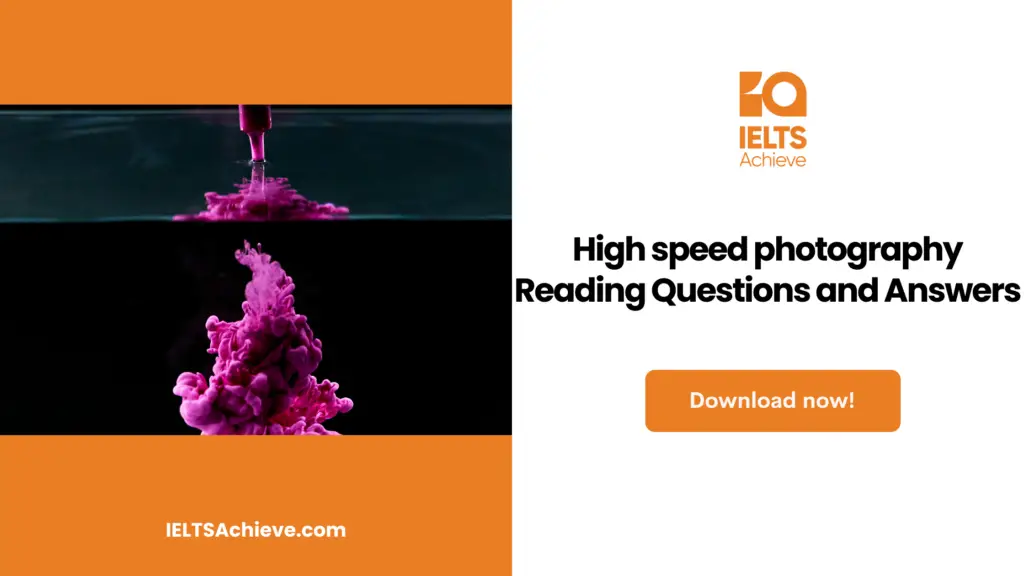The Blog post contains the following IELTS Reading Questions:
- IELTS Reading Summary Completion
- IELTS Reading Matching Features
- IELTS Reading Matching Information
Stay informed and prepared for success – Explore our comprehensive Reading Test Info page to get valuable insights, exam format details, and expert tips for mastering the IELTS Reading section.
IELTS Reading Passage – High speed photography

High speed photography
A Photography gained the interest of many scientists and artists from its inception. Scientists have used photography to record and study movements, such as Eadweard Muybridge’s study of human and animal locomotion in 1887. Artists are equally interested by these aspects but also try to explore avenues other than the photo-mechanical representation of reality, such as the pictorialist movement. Military, police, and security forces use photography for surveillance, recognition and data storage. Photography is used by amateurs to preserve memories, to capture special moments, to tell stories, to send messages, and as a source of entertainment. Various technological improvements and techniques have even allowed for visualising events that are too fast or too slow for the human eye.
B One of such techniques is called fast motion or professionally known as time-lapse. Time-lapse photography is the perfect technique for capturing events and movements in the natural world that occur over a timescale too slow for human perception to follow. The life cycle of a mushroom, for example, is incredibly subtle to the human eye. To present its growth in front of audiences, the principle applied is a simple one: a series of photographs are taken and used in sequence to make a moving-image film, but since each frame is taken with a lapse at a time interval between each shot, when played back at normal speed, a continuous action is produced and it appears to speed up. Put simply: we are shrinking time. Objects and events that: would normally take several minutes, days or even months can be viewed to completion in seconds having been sped up by factors of tens to millions.
C Another commonly used technique is high-speed photography, the science of taking pictures of very fast phenomena. High-speed photography can be considered to be the opposite of time-lapse photography. One of the many applications is found in biology studies to study birds, bats and even spider silk. Imagine a hummingbird hovering almost completely still in the air, feeding on nectar. With every flap, its wings bend, flex and change shape. These subtle movements precisely control the lift its wings generate, making it an excellent hoverer. But a hummingbird flaps its wings up to 80 times every second. The only way to truly capture this motion is with cameras that will, in effect, slow down time. To do this, a greater length of film is taken at a high sampling frequency or frame rate, which is much faster than it will be projected on screen. When replayed at normal speed, time appears to be slowed down proportionately. That is why high-speed cameras have become such a mainstay of biology.
D In common usage, high-speed photography can also refer to the use of high-speed cameras that the photograph itself may be taken in a way as to appear to freeze the motion, especially to reduce motion blur. It requires a sensor with good sensitivity and either a very good shuttering system or a very fast strobe light. The recent National Geographic footage—captured last summer during an intensive three-day shoot at the Cincinnati Zoo—is unprecedented in its clarity and detail. “I’ve watched cheetahs run for 30 years,” said Cathryn Milker, founder of the zoo’s Cat Ambassador Program. “But I saw things in that super slow-motion video that I’ve never seen before.” The slow-motion video is entrancing. Every part of the sprinting cat’s anatomy—supple limbs, rippling muscles, hyperflexible spine—works together in a symphony of speed, revealing the fluid grace of the world’s fastest land animal.
E But things can’t get any more complicated in the case of filming a frog catching its prey. Frogs can snatch up prey in a few thousandths of a second—striking out with elastic tongues. Biologists would love to see how a frog’s tongue roll out, adhere to prey, and roll back into the frog’s mouth. But this all happened too fast, 50 times faster than an eye blink. So naturally people thought of using high-speed camera to capture this fantastic movement in slow motion. Yet one problem still remains—viewers would be bored if they watch the frog swim in slow motion for too long. So how to skip this? The solution is a simple one—adjust the playback speed, which is also called by some the film speed adjustment. The film will originally be shot at a high frame (often 300 frames per second, because it can be converted to much lower frame rates without major issues), but at later editing stage this high frame rate will only be preserved for the prey catching part, while the swimming part will be converted to the normal speed at 24 frames per second. Voila, the scientists can now sit back and enjoy watching without having to go through the pain of waiting.
F Sometimes taking a good picture or shooting a good film is not all about technology, but patience, like in the case of bat. Bats are small, dark-colored; they fly fast and are active only at night. To capture bats on film, one must use some type of camera-tripping device. Photographers or film-makers often place camera near the bat cave, on the path of the flying bats. The camera must be hard-wired with a tripping device so that every time a bat breaks the tripping beam the camera fires and it will keep doing so through the night until the camera’s battery runs out. Though highly-advanced tripping device can now allow for unmanned shooting, it still may take several nights to get a truly high quality film.
G Is it science? Is it art? Since the technique was first pioneered around two hundred years ago, photography has developed to a state where it is almost unrecognisable. Some people would even say the future of photography will be nothing like how we imagine it. No matter what future it may hold, photography will continue to develop as it has been repeatedly demonstrated in many aspects of our life that “a picture is worth a thousand words.”
Unlock your full potential in the IELTS Reading section – Visit our IELTS Reading Practice Question Answer page now!
Recommended Questions:
Renewable Energy IELTS Reading Question with Answer
Questions 27-30
Look at the following organisms (Questions 27-30) and the list of features below. Match each organism with the correct feature, A-D.
27. Mushroom
28. Hummingbird
29. Frog
30. Bat
A too fast to be perceived
B film at the place where the animal will pass
C too slow to be visible to human eyes
D adjust the filming speed to make it interesting
Improve your performance in Matching Features questions by clicking here to access our comprehensive guide. Learn how to match specific features or characteristics with the options provided in the IELTS Reading section.
Questions 31-35
Complete the summary below. Choose NO MORE THAN THREE WORDS from the passage for each answer.
Fast motion (professionally known as time-lapse photography) and slow motion (or high-speed photography) are two commonest techniques of photography. To present before audiences something that occurs naturally slow, photographers take each picture at a (31)………………..before another picture. When these pictures are finally shown on screen in sequence at a normal motion picture rate, audiences see a (32)…………………….that is faster than what it naturally is. This technique can make audiences feel as if (33)………………………is shrunk. On the other hand, to demonstrate how fast things move, the movement is exposed on a (34)……………………of film, and then projected on screen at normal playback speed. This makes viewers feel time is (35)……………….
Boost your performance in Summary, Notes, Table, and Flowchart Completion tasks. Click here to explore our detailed guide and learn how to effectively complete summaries, notes, tables, and flowcharts in the IELTS Reading section.
Questions 36-40
Reading Passage 3 has seven paragraphs, A-G. Which paragraph contains the following information?
36. a description of photography’s application in various fields
37. a reference to why high-speed photography has a significant role in biology
38. a traditional wisdom that assures readers of the prospects of photography
39. a reference to how film is processed before final release
40. a description of filming shooting without human effort
Master the art of matching information and boost your score in the IELTS Reading section. Click here to access our step-by-step guide on handling Matching Information questions effectively.
Unlock your full potential in the IELTS Reading section – Visit our IELTS Reading Practice Question Answer page now!
Recommended Questions:
Renewable Energy IELTS Reading Question with Answer

We hope you found this post useful in helping you to study for the IELTS Test. If you have any questions please let us know in the comments below or on the Facebook page.
The best way to keep up to date with posts like this is to like us on Facebook, then follow us on Instagram and Pinterest. If you need help preparing for the IELTS Test, join the IELTS Achieve Academy and see how we can assist you to achieve your desired band score. We offer an essay correction service, mock exams and online courses.


